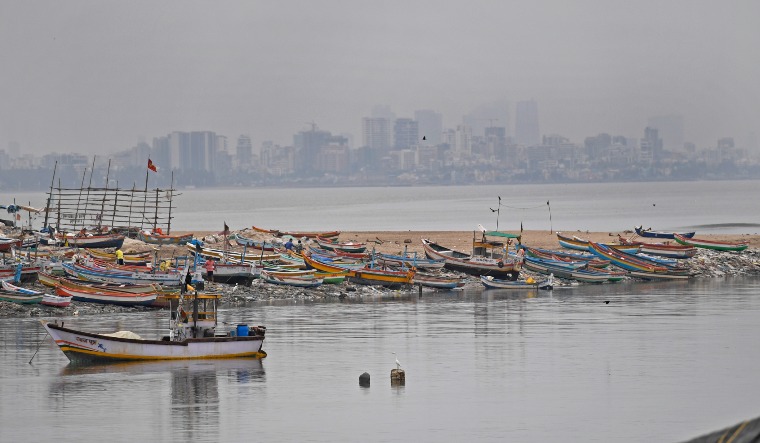As Cyclone Nisarga struck coastal Maharashtra, Mumbai emerged largely unscathed. As per a Maharashtra government statement, six persons lost lives in incidents related to the cyclone, while 16 suffered injuries. Six cattle were also killed. Trees and electricity poles were uprooted in many areas. Parts of Raigad district plunged into darkness and telephone connectivity too was hit in the area.
Maharashtra Chief Minister Uddhav Thackeray directed the authorities to provide aid of Rs 4 lakh to the kin of those killed, the CMO statement said, adding that he asked for panchnamas to be completed in two days so that assistance can be provided to farmers and others. Electricity will be restored soon, he said.
Since there is shortage of water for cooking purposes in some areas of the district, people should be provided food, the chief minister said. In the Mumbai Metropolitan Region, the people who were shifted to temporary shelters should be tested for coronavirus before they are allowed to go back home, he said.
Mumbai has always been largely shielded from cyclones courtesy its geography. Due to a multitude of reasons, cyclones in the Arabian Sea tend to move in a north-westerly direction which takes them to the African coasts or the Arabian Peninsula. In some cases, Gujarat could be affected. However, the possibility of tropical cyclones in Mumbai has always been a cause of concern for researchers, as the financial hub is a low-lying coastal city with a massive population and very high stakes.
“Cyclones in the Arabian Sea are mostly formed in the central Arabian Sea. The reason Mumbai has been shielded is because they [cyclones] do not form close to the coast. Even if they do form close to the coast, they move towards Oman, Yemen or Somalia because of upper-level steering winds that move from east to west,” Sridhar Balasubramanian, associate professor, department of mechanical engineering and associated faculty, IDP in Climate Studies, Indian Institute of Technology Bombay, told the Hindustan Times.
One of the largest cyclones to have hit Mumbai was believed to be a June 5, 1882, super cyclone that claimed over 1 lakh lives; however, recent researches have shown that to be a hoax.
What was the 1882 Bombay cyclone claims?
There are multiple sources, as pointed out by researchers. The book Divine Wind by Kerry Emanuel lists the 'Great Bombay Cyclone of 1882'; Disastrous History of the World: Chronicles of War, Earthquake, Plague and Flood written by John Withington, published in 2010, has mentions of the cyclone; Encyclopedia of Hurricanes, Typhoons, and Cyclones by David Longshore goes into the devastation of the Great Bombay Cyclone of 1882. The death toll is most commonly placed at 1,00,000.
P. Mukhopadhyay and M. Mahakur of the Indian Institute of Tropical Meteorology, Pune, in an Ocean's Digest piece argued that, based on Indian Meteorological Department (IMD) archives, the cyclone was a "myth".
"[From IMD archives] It is clear that no cyclone or depression passed over Bombay [now Mumbai] in the month of June. IMD also has a precious collection of a report Cyclone Memoirs written by J. Eliot and published in 1891. This article provides the brief account of all recorded cyclones over Arabian Sea during 1648-1889. This report mentions a 44th storm during 27 May–2 June of 1881 and it next mentions the 45th storm over Arabian Sea during July 3-4, 1883. Interestingly, it did not mention about any storm over Arabian Sea during 1882," according to the authors.
In a July 2019 study, Tropical Cyclone Hazard to Mumbai in the Recent Historical Climate, researcher Adam H. Sobel and associates argue that there are not enough historical documents to prove the occurrence of such a cyclone. According to the researchers: "Most of the sources provide little detail or description of the 1882 event. Many of them are simply lists of the worst tropical cyclone disasters in known world history, with the Bombay cyclone of 1882 included among them. One source (Longshore 2008) provides a paragraph; this is the most extensive description of which we are aware."
"Apart from meteorological archives, it is difficult to imagine that a disaster in which 1,00,000 people were killed, in a city of Bombay’s size and importance—and one that was a major center of the British empire at the time—could have gone undocumented in historical records. A cursory search, supplemented by communication with two historians with expertise in nineteenth-century India [G. Prakash 2015, and S. Amrith 2018, personal communications], reveals no such documentation of such an event. Given these considerations, it appears to us most likely that the event simply did not occur at all," the researchers claimed.



